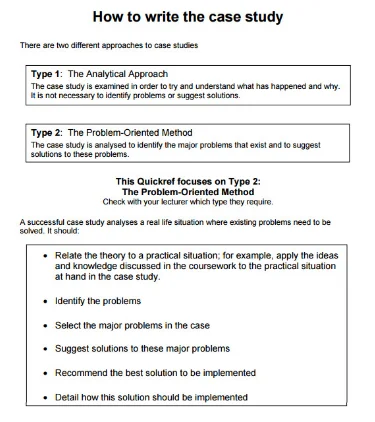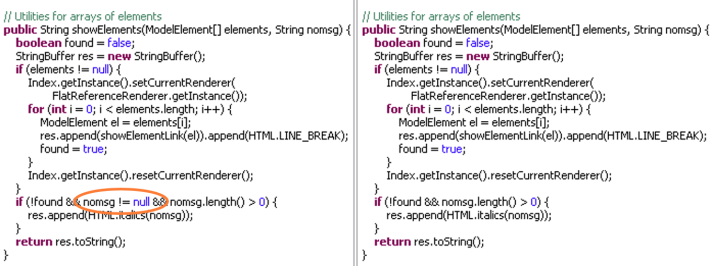Masters Compare - Find your perfect masters course.

- Studying a Postgraduate degree

How to use a case study in your masters dissertation
Share this article.
- Facebook Sharer
- Twitter Sharer
- LinkedIn Sharer

Explore other topics
- Funding a Postgraduate course
- Living as a Postgraduate student
- Popular masters degree subjects
- Student Wellbeing
- Finding a PhD or Masters Course
Think Postgrad
Frequently asked questions.
Yes, in fact a case study is a very good option in your dissertation. There are multiple ways to implement a case study in your thesis. For instance, one main study which is in depth and complex or you could feature multiple case studies.
Case studies are a way to research a particular field, group, people and situation. The topic of research is studied deeply and thoroughly in order to solve a problem or uncover information. Case studies are a type of qualitative research.
If you are ready to find a masters course check out Masters Compare.
Prof Martyn Denscombe, author of “ The Good Research Guide, 6th edition ”, gives expert advice on how to use a case study in your masters dissertation.
There are two main examples for how to use a case study in your masters dissertation, namely quantitative and qualitative case studies.
First, a case study provides a platform that allows you to study a situation in depth and produce the level of academic inquiry that is expected in a master’s degree. In the context of any master’s programme the dissertation operates as something of a showcase for a student’s abilities.
It can easily make the difference between getting a merit and a distinction in the final award of degree. It is important, therefore, to base the work on an approach that allows things to be explored in sufficient depth and detail to warrant a good grade.
Second, case studies can be useful in a practical sense. It is possible to complete a case study in a relatively short period of intense study and so it is the kind of research that is feasible in terms of the kind of time constraints that face master’s students as they enter the final stages of their programme of study.
Added to which a case study can also be a rather convenient form of research, avoiding the time and costs of travel to multiple research sites. The use of case studies, then, would appear to be an attractive proposition. But it is not an approach that should be used naively without consideration of its limitations or potential pitfalls.
To be a good case study the research needs to consider certain key issues. If they are not addressed it will considerably lower the value of the master’s degree. For instance, a good case study needs to:
- Be crystal clear about the purpose for which the research is being conducted
- Justify the selection of the particular case being studied
- Describe how the chosen case compares with others of its type
- Explain the basis on which any generalizations can be made from the findings
This is where The Good Research Guide, 6th edition becomes so valuable. It not only identifies the key points that need to be addressed in order to conduct a competent questionnaire survey.
It gets right to the heart of the matter with plenty of practical guidance on how to deal with issues. Using plain language, this bestselling book covers a range of alternative strategies and methods for conducting small-scale social research projects. It outlines some of the main ways in which the data can be analysed.
Read Prof Martyn Denscombe’s advice on using a questionnaire survey for your postgraduate dissertation
- Advertisers
- Cookie Policy
- Terms and Conditions
Sorry! You need to sign up
Sign up to Postgraduate Studentships
Sign up to compare masters
Opportunity added!
Thanks for making your selection. Click below to view your list.
Course Added
Thanks for making your selection. Click below to view your comparisons.

Think Postgrad Ltd 2008-2024 Website By Parachute

Achieving Success in Thesis and Case Study for Doctoral and MPH Students

Blog Summary
Embarking on the journey of writing a thesis or dissertation or delving into case studies can be daunting and exhilarating for doctoral and MPH students. These academic endeavours are crucial milestones in one’s educational journey, showcasing mastery of subject matter, independent research skills, and critical thinking abilities. In this comprehensive guide, we will navigate through the intricacies of each component, offering invaluable insights and practical tips to ensure success in your academic pursuits.
Understanding Thesis and Dissertation Distinctions
At the outset, grasping the nuances between a thesis and a dissertation is imperative. While the terms are often used interchangeably, they differ in scope, depth, and purpose.
A thesis, commonly associated with a master’s degree program, typically focuses on a narrower research topic or question. It demonstrates the student’s mastery of the subject matter and ability to conduct independent research within a limited scope. The examination process for a thesis may involve evaluation by a committee of faculty members, with the students often required to defend their work orally.

Did You Know a PhD in Management Degree Can Be Done Online?

TSL-UCN Is the Best School to Pursue an Online Public Health Degree!

Know the Career Opportunities with a Doctorate in Business Administration

How to Choose Between Master of Business Administration (MBA) and Executive MBA

Why Should You Get a Doctor of Business Administration Degree?
Related posts.

Extend your Success by Procuring a Public Health Degree from Texila


Fuel Your Passion for Research: Dive Deep with a PhD

Obtaining Master’s Degree in Business Management with Texila American University for a Global Recognition

Career Opportunities – Students Prefer to Study PhD with Texila

Earn a Public Health Degree with Texila and Enhance your Career

Develop your Knowledge about Public Health Education to Enhance your Career Growth
- More Networks
- Have your assignments done by seasoned writers. 24/7
- Contact us:
- +1 (213) 221-0069
- [email protected]

Can Dissertation be a Case Study: Research Example and Format

write Case study as dissertation
Also known as a thesis, a dissertation usually comes at the end of a degree course. Unlike essays and other standard research papers, a dissertation is a large project that requires a deeper depth of research.
The research can take up to the final six months of your degree course. The significance of this type of research is to test the ability of a student to do independent research. A student comes up with his or her idea, does thorough research then structures the content to make a final research paper.

In essence, this stage of your degree course teaches you how to manage your time and sharpen your working skills.
A student usually works with the department supervisor to make dissertation writing easier. The supervisor can help in planning the writing of the dissertation. The purpose of the supervisor is to provide guidance, feedback, and advice as you progress from stage one of writing to the end.
People Also Read: Test Taking Strategies For Students: A Comprehensive Guide
Can Dissertation Be a Case Study?

There are very few instances when a dissertation is used as a case study because of the differences.
If you opt to use your dissertation as a case study, ensure that you do not focus on providing a solution to the problem.
If it is an already-written dissertation, it requires a lot of editing. In a dissertation, you provide the solution to a problem, but in case studies, only analysis of events is enough to complete the project.
How to Incorporate Case Study into Your Dissertation
A good qualitative case study can form the perfect basis for your dissertation and save you a lot of time.
To start with, a case study gives you the avenue to deeply analyze a situation. Precisely so, it will be easier for you to exhibit the academic survey level that your degree requires.
A good case study can be used in your dissertation in a practical sense.
In the final stages of your degree, time constraints are tight and a case study will take you a relatively short period to complete, unlike a dissertation. Therefore, it is an appropriate form of research that saves the time taken to navigate multiple research sites.
However, to incorporate a case study into your dissertation, pay attention to the potential drawbacks and limitations involved.
To avoid lowering the value and quality of your research, the following are some of the considerations to observe when selecting a proper case study for your dissertation:
a) The case study ought to be clear and in uniformity with the research purpose .
b) The particular case you choose, should be justified.
c) There has to be a clear explanation concerning the basis of the overviews made from your research results.
d) The case study should have a comparison between the chosen cases and others .
To date, many students use case studies as an obvious option for research projects.
All in all, be careful how you implement the study into your research as many professors may view a dissertation as one that lacks rigor and consistency. Despite this skepticism, case studies can offer more exhaustive insights that ordinary research cannot achieve.
People Also Read: Hardest Essay Topics For High School and University Students
How to Write Case Study Only as Your Dissertation
A case study and a dissertation share a lot of similarities but they are not the same.

In case studies, there is a full introduction of a topic. But, the opinion of the writer and other similar works do not need citation. Equally, a dissertation requires the citing of a writer’s view as well as that of other similar works.
A student who is about to graduate is supposed to know instances when case studies can be used as a dissertation and when they cannot.
If you are worried about writing a great dissertation that will excite your lecturer, you can opt for the case study method.
Here are important steps to follow in writing a case study only as your dissertation:
- Start by defining the particular question you are going to address in the paper. It will be easier if you create specific questions that will answer the main parts of the situation. Develop your focus of research to get all the information about the topic.
- Design the process of the case study. Come up with a clear roadmap of the selected real-life cases and ensure you know the reason why you have chosen them. Also, do not forget to enlighten more information about the research methods you intend to adopt for data collection and analysis.
- A case study written only as a dissertation needs a huge amount of data. Needless to say, a writer should develop a clear plan for data collection.
- With your plan ready, proceed to the field and collect data. At this stage, do not make any interpretation of results until the research process is complete.
- Having done that, present the data by reporting in a flowing manner. Use simple language for readers to understand your interpretations effortlessly.
Formatting the Case Study
Following the right format guarantees a good case study paper that you can use to impress the professor as a dissertation.
Start with an introduction or an exclusive summary to inform the reader about the findings and analysis of the case study.

Secondly, provide background information by writing clear facts and pinpointing the topic issues to your audience.
The next part is to embark on the methods and findings.
This is a discussion that entails verdicts of the case you have chosen and should be divided into separate sections for easier understanding.
Afterward, come to the section where you will provide the recommendations and how to implement them. Here, a writer should discuss the solution chosen, give clear reasons why it is the right one, and how to put it into practice.
Good solutions usually focus on realistic means of improving the situation or solving it.
You can give evidence as a backup for the solutions you have proposed. The final part is to write a conclusion that summarizes all the important points from the evaluations and solutions of the case study.
3 Examples of Case Study Topics to Write as Dissertations
To arrive at a good case topic idea, hunt for the ultimate topic that inspires you. From the possible list of selections you have, narrow down to topics that reflect the main idea you want.
After arriving at the topic of choice, select the right methodology for research. Below are good topics you can select for your case study:
1. Why start-up businesses are on a steady rise.
2. Research study cases on patients with Omicron coronavirus and the latest nursing methods for the virus.
3. Case study on the rise and rise of TikTok.
People Also Read: 1200 Words Essay: How Many Pages, How to Write& Its Structure
Regardless of the course you have selected or your academic objectives, a college student needs a good case study. The quality of this study will depend on the topic you select.
Therefore, if you select a topic correctly, your ideas will be well organized and you can use available research methodologies to write an interesting case study.
There are different categories of ideas you can base your study on depending on the subject you want. You can focus on titles ranging from information technology to psychology, education, and environmental science.
There are also good topic ideas you can derive from applied physics, marketing, management, human rights case studies, or even nursing.

When not handling complex essays and academic writing tasks, Josh is busy advising students on how to pass assignments. In spare time, he loves playing football or walking with his dog around the park.
Related posts

Publishing Literature Reviews
Can Literature Reviews Be Published: Can I Publish on my Own

Is Doing a Dissertation worth It
Is Doing a Dissertation worth It: Benefits of Writing it

Optimal Dissertation Length
Dissertation Length: Optimal Length in Words and Pages
Thesis Guide
How to Write a Case Study
Most good empirical software engineering papers that contain a study follow the same structure for its presentation. As far as I know, this structure was not invented by a single researcher, but developed gradually over the course of many publications.
Professional readers expect your case study to follow this structure, too. The audience that really matters for your publication—your thesis supervisor, his PhD advisor or program committee members—all are professional readers.
The goal of this article is to describe this structure: the basic building blocks of thesis chapters or paper sections that make up case study presentations. It is meant as an introduction and thus necessarily skips details. For further reading, this article contains links at the end.
Basic Anatomy
The typical structure comprises these sections:
- Research questions
Study Objects
Study design.
Study Procedure
Results & Interpretation
Threats to Validity.
As a reader, I expect each section to answer a specific set of questions. In the following, I describe the gist of each section, its set of questions and common mistakes.
To make the sections more tangible, I use part of a study from one of our papers . The study investigates inconsistencies in code clones.
Research Questions
This section states the questions that the study aims to answer and their rationale. It should contain:
- What the questions are. In my paper, RQ 1 is Are clones changed inconsistently? .
Why the research questions are relevant.
A frequent mistake is missing rationale. In such papers, the motivation behind the research question often remains unclear or unconvincing.
Some background on the example paper: code clones are duplicated pieces of source code in a software systems. Clones are typically created by copy & paste. They hinder software maintenance, since changes must often be made to all clone instances. If a clone gets forgotten during such a change, the code becomes inconsistent. This inconsistency can be a bug.

What I wanted to investigate with my study, was how big of a problem this is in practice. One the one hand, I had seen some instances of inconsistent clones that suspiciously looked like bugs. On the other hand, I had no idea how frequently this occurred, and if this really was problematic in practice. My study goal was to quantify this by analyzing clones (and their inconsistencies) in real systems.
The rationale of the first research question was to understand if inconsistent changes to clones happen at all, and how often. If they are very rare, they probably do not deserve further investigation (which is performed by the later research questions in the paper).
This section outlines the study objects (e.g. software systems), which the study analyzes to answer its research questions. It should contain:
- The names of the study objects and their characteristics (those properties that are relevant for the study). In the example, the study objects were the 5 systems that I searched for clones. The relevant characteristics comprise programming language, size, age, number of developers and a short description of their functionality.
Why (and maybe how) those objects were chosen. This is relevant, since choice can influence study result validity. For the example, a large number of study objects (and ideally their random selection from a large pool of potential study objects), would increase the generalizability of the study results.
In the clone paper, however, I needed to do interviews with the system’s developers for later questions. I thus had to rely on our industry contacts to get hold of these developers. This limited my choices and thus potentially affects generalizability of the results (which is mentioned in the threats to validity section).
A frequent mistake is to not mention why those objects were chosen and what the consequences of the choice are. As a reader, this makes me wonder if the selection was manipulated to better produce the answers the author was looking for.
If a study involves data from industry, the study object names are often anonymized (e.g. replaced by A , B , C , …). As a reader, I don’t care about this, since the names of proprietary industrial systems are meaningless to me anyway. For the authors, however, it makes it much easier to get clearance to publish these results.
This section describes how the study, using the information from the study objects, attempts to answer the research questions.
For the clone study, I computed the percentage of inconsistent clones among all clones. For this, I defined two sets:
- C : The set C of consistent clones. The clones in each clone group are consistent (i.e. contain no differences or only small ones, like renamed variables).
IC : Set of inconsistent clones , i.e. clone groups with substantial differences between clones, such as missing statements.
As the answer to the research question, I computed the inconsistent clone ratio as |C| / |IC|. Intuitively, it denotes the probability that a clone group in the system contains at least one inconsistency.
A common mistake is to interleave study design, procedure and implementation details.
This section describes the nitty gritty details required to implement the study design in reality. In principle, they could also be included directly in the description of the study design. However, it is easier for the reader to first understand the general idea, and then the details.
For the clone study, this section states detection parameters (like minimal clone length and number of allowed differences between clones). It also treats handling of false positives, generated code and overlapping clone groups.
This section describes the results and interprets them with respect to the research questions. Since there is often a lot of data, this section should guide the reader through the results. In studies with large amounts of data, it is often easier to read to separate description of the data from its interpretation.
In the example, the paper presents the results for each study object and then the aggregated ratio. On average, 52% of the clone groups contained inconsistencies. The paper thus answers the question positively: yes, clones are changed inconsistently.
A common mistake is to mix the results with the discussion. This makes it harder for the reader to separate backed-up results from speculation.
Interpretation of the results that go further than the research questions. This can, e.g., contain implications for software development.
The clone paper (based on the above presented and further questions) concludes, that clones are a threat to program correctness, implying that their proper management deserves more attention.
Threats to Validity
This section lists all threats, i.e. reasons why the study results could be wrong. Ideally, it then treats every single threat and describes what you did to make sure that this threat does not invalidate your study results.
Threats to validity are often classified into internal and external threats.
Internal threats are reasons why the results could be invalid for your study objects. In the example, the parameter values of the clone detector have a strong impact on the detected clones. The section states that we mitigated the threat through a pre-study we performed in order to validate the chosen parameter values.
(To be honest, this is a weak mitigation. What it really says is that we tinkered with the values until they felt good and then did the study. A stronger mitigation would be to also perform the study with different parameter values and investigate whether the general results still hold. Since this distracts from the main study, such back-up studies are often only described in a much abbreviated fashion in the threats section itself.)
External threats are reasons why the results encountered for the study objects might not be transferable to other objects. In the example, the way we chose the study objects (through our personal network) might bias our results. To mitigate this threat, we at least chose systems that had different characteristics, such as programming language, development contractor and age.
The most common mistake is to ignore threats entirely. Much better (but still improvable) is to state a threat without giving a mitigation or an estimation of its severity.
Variation Points
The case study structure described in this article can be used in two different decomposition styles. The most common one is described in this article. It orders by section first and by research question second:
- Research questions 1.1: RQ 1 … 1.2: RQ 2 …
Study Objects 2.1 For RQ 1: … 2.2 For RQ 2: …
Study Design 2.1 For RQ 1: … 2.2 For RQ 2: …
Is most frequent alternative, however, is to order by research question first and by section second:
- RQ 1 1.1 Research question 1 … 1.2 Study Objects for RQ 1 … 1.3 Study Design for RQ 1… …
RQ 2 2.1 Research question 2 … 2.2 Study Object for RQ 2 … 2.3 Study Design for RQ 2 … …
Both decomposition styles have advantages and drawbacks. I use these heuristics to select the decomposition level:
This is the case in the clone paper example. Research questions two and three ask whether the inconsistencies between clones are unintentional, and if so, whether they represent a fault. RQ n thus builds upon the results of RQ n-1 . Since the study sections share so much, describing them in isolation would create a lot of redundancy. They are thus easier to read all at once. Decomposition by study section facilitates this.
By research questions : when each study has its own study objects, design and procedure.
In this paper we wrote , the study objects, design and procedure of research questions one and three have nothing in common. Since there is little synergy between them, it is easier to read a complete study—from question to results interpretation—before reading the next one.
Apart from the above examples, there are mixed cases as well (where some RQs share objects and design, but others in the same paper don’t). For them, simply choose the decomposition style that feels right, but stick to it for the entire study description. Don’t mix decomposition styles, since this confuses the reader.
From my experience, you only really get to feel if a style feels right, once you write it down, often two times, once in each decomposition style. This is tedious, but pays off, since a suitable decomposition style strongly increases the readability of your study.
Further reading:
- Guidelines for conducting and reporting case study research in software engineering by Per Runeson & Martin Höst.
Case Study Research. Design and Methods by Robert K. Yin.
Thanks to Rainer Koschke and Stefan Wagner for literature suggestions and to Daniela Steidl for reading drafts of this.
Sharen mit:
Published by elmarjuergens.
Informatiker, Software-Analyst, Sprecher, Wein- und Biertrinker. View all posts by ElmarJuergens
Leave a comment Cancel reply

- Already have a WordPress.com account? Log in now.
- Subscribe Subscribed
- Copy shortlink
- Report this content
- View post in Reader
- Manage subscriptions
- Collapse this bar

IMAGES
COMMENTS
Second, case studies can be useful in a practical sense. It is possible to complete a case study in a relatively short period of intense study and so it is the kind of research that is feasible in terms of the kind of time constraints that face master's students as they enter the final stages of their programme of study. Added to which a case ...
Thus, in a case study thesis, prior theory provides a focus to the data ... example, in one master's thesis of 60,000 words, only fiv e cases were available. This was towards the lower end of ...
the Technical University Berlin. The master thesis project started in February 2012 and has been accomplished in August 2012. The multiple case studies were only possible by the cooperation of five German start-ups where founders and employees have been interviewed. I want to thank these participants of the study for
Construction Project - a case study Master of Science Thesis in the Master's Programme Design and Construction Project Management EWELINA GAJEWSKA MIKAELA ROPEL Department of Civil and Environmental Engineering Division of Construction Management CHALMERS UNIVERSITY OF TECHNOLOGY Göteborg, Sweden 2011 Master‟s Thesis 2011:47
Master Thesis - Weiguang Zhang McMaster University- Computing and Software ii MASTER OF SCIENCE (Jan, 2012) McMaster University (Computer Science) Hamilton, Ontario TITLE: A SUITE OF CASE STUDIES IN RELATIONAL DATABASE ... To this end a suite of ten case studies are presented. Each project is taken from its informal specification to a relational
You are going to write a Master's thesis, a demanding and intellectually . challenging task. As one of the capstone experiences of graduate study at Central Connecticut . ... p.33). Case studies, ethnographies, and narrative experiences are just a few methods associated with qualitative research. Qualitative approaches involve clear standards
Literature Review Thesis/Dissertation: This type focuses on reviewing and synthesizing existing literature on a specific research topic. Students critically analyze and evaluate a body of literature to identify key themes, theories, and gaps in knowledge. Case Study Thesis/Dissertation: Involves an in-depth analysis of a specific case or set of ...
Also known as a thesis, a dissertation usually comes at the end of a degree course. Unlike essays and other standard research papers, a dissertation is a large project that requires a deeper depth of research. ... The case study ought to be clear and in uniformity with the research purpose. b) The particular case you choose, should be justified ...
This section outlines the study objects (e.g. software systems), which the study analyzes to answer its research questions. It should contain: The names of the study objects and their characteristics (those properties that are relevant for the study). In the example, the study objects were the 5 systems that I searched for clones.
road and to avoid high turnover rates (Shatté, 2015). Hence, this thesis first aims to examine the role of the founder in fostering a stable organizational culture. As a second step, the cultural practices that serve as commitment factors among start-up employees are examined. The thesis is a case study and will focus on the Danish start-up ...